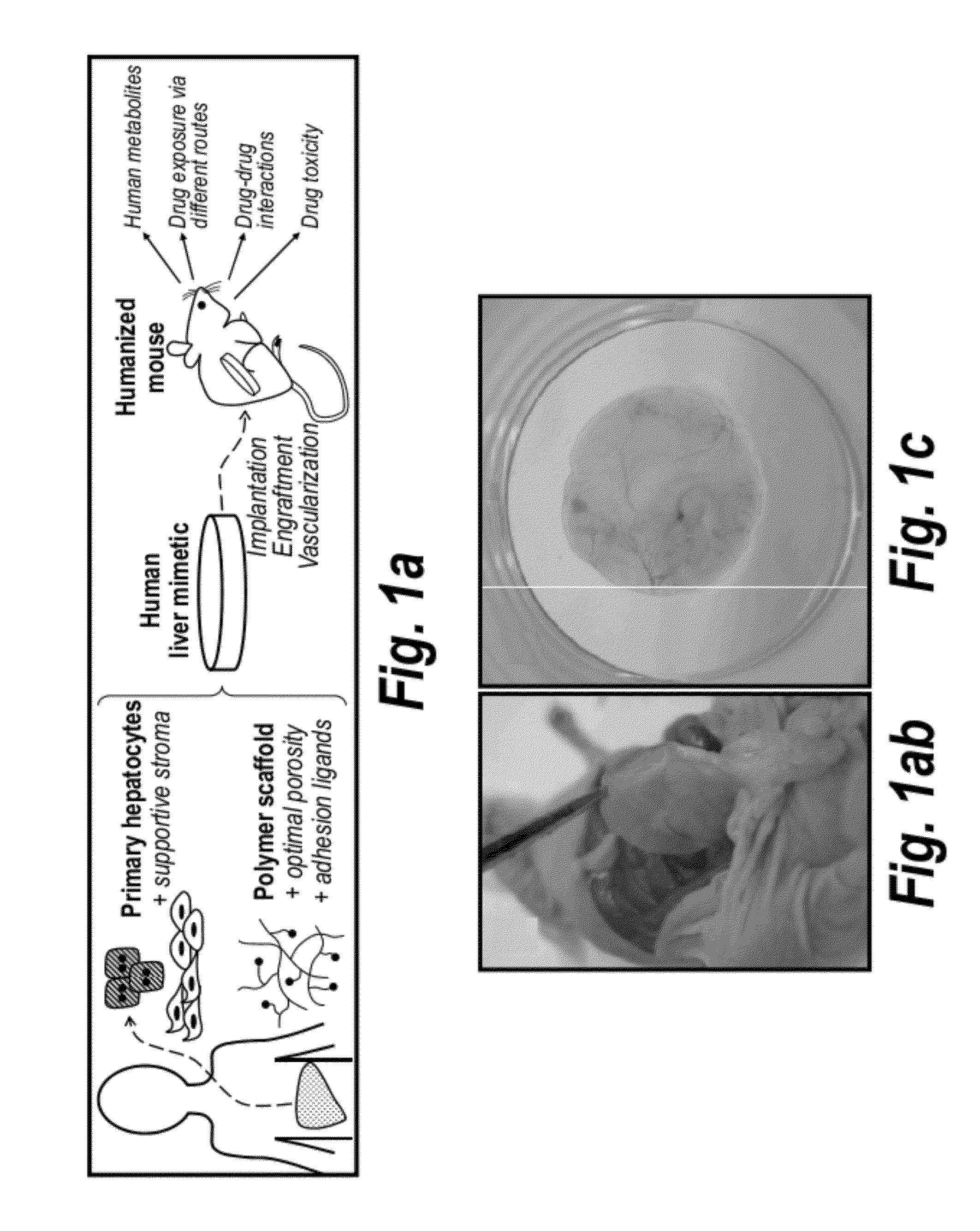Humanized animals via tissue engineering and uses thereof
a tissue engineering and humanized animal technology, applied in the field of humanized animals via tissue engineering, can solve the problems of increasing the time (weeks) of liver model mice generation, and reducing the number of liver model mice, so as to achieve the desired morphology and reduce the time, cost and labor. , the effect of sufficiently stabilizing the desired morphology
- Summary
- Abstract
- Description
- Claims
- Application Information
AI Technical Summary
Benefits of technology
Problems solved by technology
Method used
Image
Examples
example 1
Materials and Methods
[0193]Fabrication and culture of implantable liver mimetics. Liver mimetics were fabricated using a hydrogel polymerization apparatus. In brief, cellular pre-polymer solution was loaded into a 20-mm diameter, 250 mm-thick silicone spacer, and the solution exposed to UV light from a spot curing system with collimating lens (320-390 nm, 10 mW / cm2, 20-30 s; EXFO Lite). Pre-polymer solution comprised of polyethylene glycol diacrylate (PEGDA 20 kDa at 10% w / v; Laysan Bio, Inc.), 0.1% w / v Irgacure 2959 photoinitiator, and 15 mmol / ml acrylate-PEG-peptide monomers. Acrylate-PEG-peptide monomers were synthesized by conjugating RGDS or RGES to acrylate-PEG-N-hydroxysuccinimide (3.4 kDa) at a 1:1 molar ratio in 50 mM sodium bicarbonate buffer (pH 8.5). Reactions were dialyzed overnight against 1000 kDa MWCO cellulose ester membrane and lyophilized for long-term storage at −80° C. Hepatocyte / fibroblast co-cultures were encapsulated at a final concentration of 8×106 hepatocy...
example 2
Implantable Human Liver Mimetics
[0197]A tissue engineering approach to establish a novel humanized liver mouse model which can be generated rapidly and reproducibly among mice with diverse backgrounds, and which is broadly enabling for research and drug development was used in this study. (FIG. 1a) This approach leverages a micro-engineered hydrogel scaffold capable of functionally stabilizing primary hepatocytes ex vivo, delivering hepatocytes to accessible ectopic sites in vivo, and integrating with host mouse circulation (FIGS. 1b and 1c).
[0198]Primary hepatocytes representing the full complement of liver functions and drug metabolism pathways are ideal cells for building implantable human liver mimetics but are challenging to maintain upon isolation. To engineer an implantable microenvironment for stabilizing primary human hepatocytes ex vivo, the effects of hepatocyte-nonparenchymal cell interactions with stromal fibroblasts in 2D and 3D culture models were analyzed. Co-cultiva...
example 3
Characterization of Human Liver Mimetics
[0201]In order to assess the utility of tissue-engineered hepatocyte cultures for drug metabolism studies, we characterized human liver mimetics, or HEALs, for the expression and function of human drug-metabolizing enzymes, comparing 3D-encapsulated HEP / FIB HEALs to same-donor 2D HEP / FIB cultures on day 10 of culture. The 2D condition acts as reference for a stable hepatocyte coculture model, previously shown to express a number of genes pertinent to ADME / Tox in vitro. However, to date, assessment of hepatocyte models has hinged on the measurement of only a small handful of drug-metabolizing enzymes. Noting that drug-metabolizing enzymes are regulated primarily at the level of transcription, we hypothesized that we could comprehensively assess drug-metabolizing enzyme expression levels in a low-cost, high-throughput assay based on the multiplexed ligation mediated amplification (LMA) of transcripts coupled to detection on Luminex beads. Accord...
PUM
| Property | Measurement | Unit |
|---|---|---|
| thickness | aaaaa | aaaaa |
| thick | aaaaa | aaaaa |
| thickness | aaaaa | aaaaa |
Abstract
Description
Claims
Application Information
 Login to View More
Login to View More - R&D
- Intellectual Property
- Life Sciences
- Materials
- Tech Scout
- Unparalleled Data Quality
- Higher Quality Content
- 60% Fewer Hallucinations
Browse by: Latest US Patents, China's latest patents, Technical Efficacy Thesaurus, Application Domain, Technology Topic, Popular Technical Reports.
© 2025 PatSnap. All rights reserved.Legal|Privacy policy|Modern Slavery Act Transparency Statement|Sitemap|About US| Contact US: help@patsnap.com



